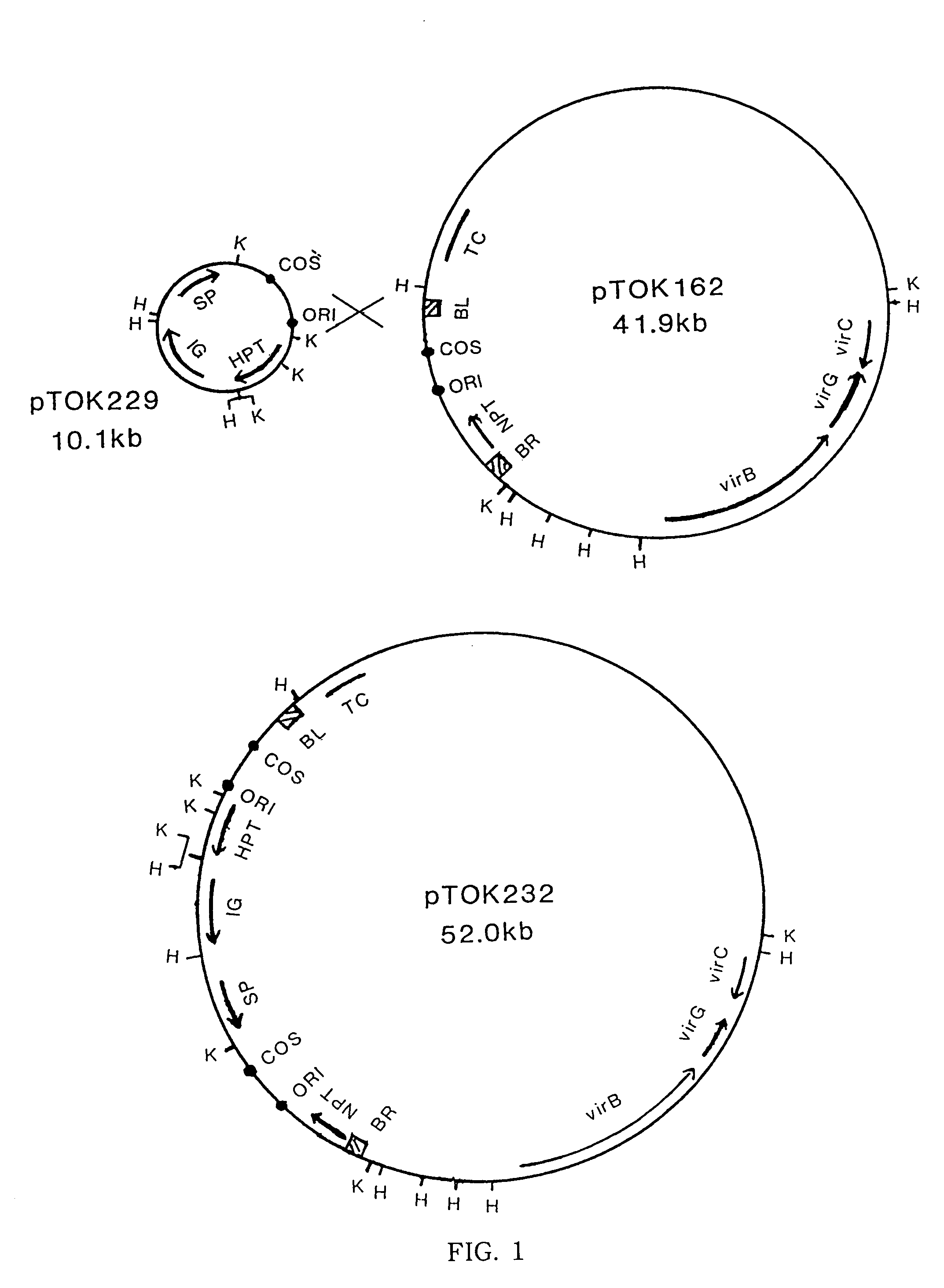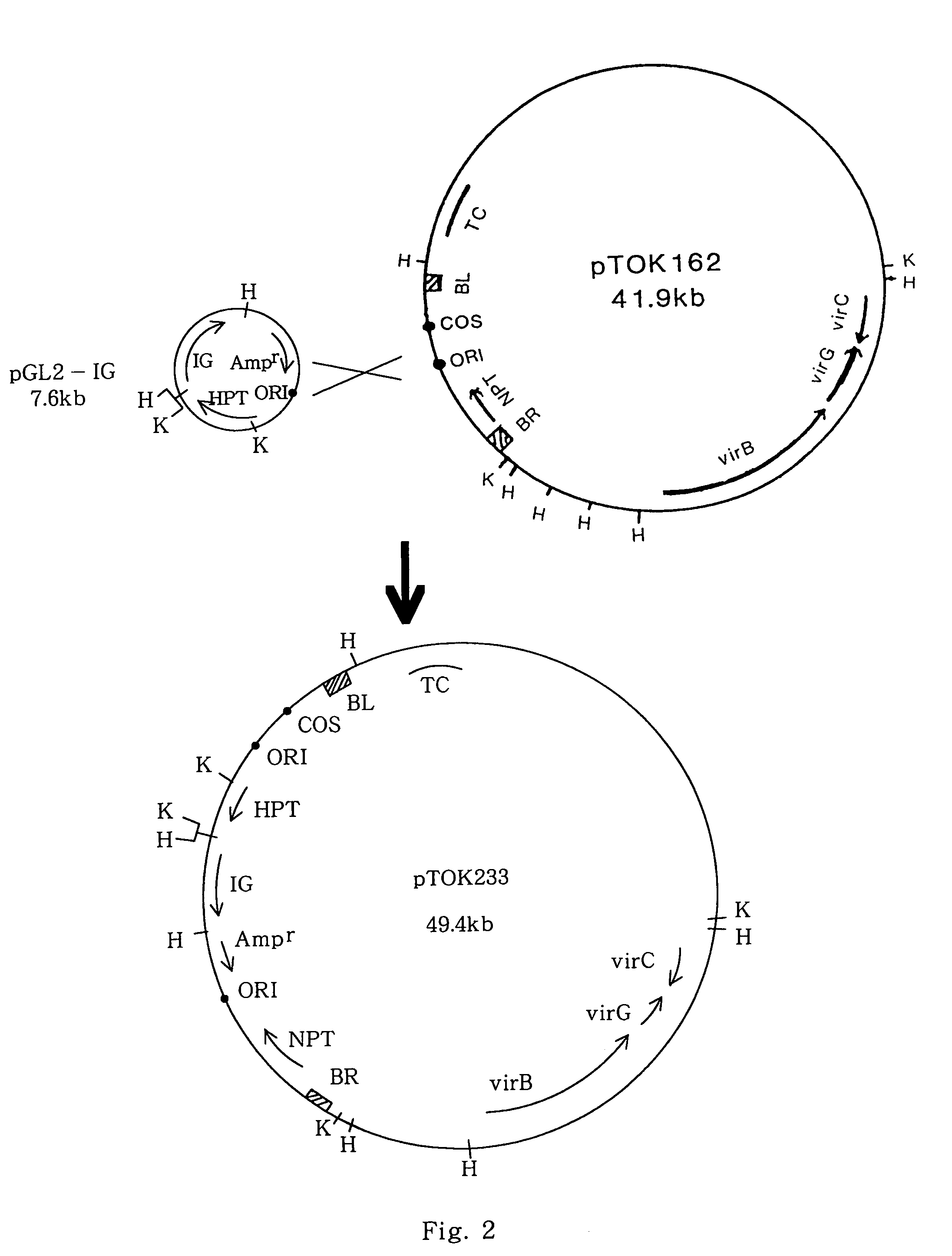Method for transforming monocotyledons
- Summary
- Abstract
- Description
- Claims
- Application Information
AI Technical Summary
Benefits of technology
Problems solved by technology
Method used
Image
Examples
example 1
(1) Preparation of Sample Cultured Tissues
(i) Variety of Rice
[0047]Varieties Asanohikari, Tsukinohikari and Koshihikari, which are varieties of japonica rice were selected as samples.
(ii) Scutellum and Scutellum Callus
[0048]Mature seeds of rice were sterilized by being immersed in 70% ethanol for 1 minute and then in 1% sodium hypochlorite solution for 30 minutes. The seeds were then placed on 2N6 solid medium (inorganic salts and vitamins of N6 (Chu C. C., 1978; Proc. Symp. Plant Tissue Culture, Science Press Peking, pp. 43–50), 1 g / l of casamino acid, 2 mg / l of 2,4-D, 30 g / l of sucrose, 2 g / l of Gelrite). Scutella were removed from the seeds on Day 4 from the beginning of the culture on 2N6 solid medium and used as “scutellum” samples. On the other hand, after culturing the mature seeds for about 3, weeks, the formed calli originated from scutella were transferred to 2N6 medium and cultured therein for 4–7 days. The resulting calli were used as “scutellum callus” samples.
(ii) Shoo...
example 2
(1) Maize Varieties
[0096]Maize varieties A188, F1 (A188×Black Mexican Sweet), F1 (A188×B73Ht), F1 (B73Ht×A188) and F1 P3732 were selected as the sample materials. The varieties of A188, Black Mexican Sweet and B73Ht were obtained from the National Institute of Agrobiological Resources, Ministry of Agriculture, Forestry & Fisheries, and P3732 was obtained from IWATA RAKUNOU KYODOKUMIAI.
(2) Preparation of Tissues in the Vicinity of the Growth Point
[0097]Mature seeds were immersed in 70% ethanol for 1 minute and in 1% sodium hypochlorite for 5 minutes. The seeds were then washed three times with sterilized water and were placed on LS solid medium (inorganic salts and vitamins of Linsmaier and Skoog; Linsmaier, E. and Skoog, F. 1965; Physiol. Plant 18: 100–127, 100 mg / l of casamino acid, 700 mg / l of proline, 20 g / l of sucrose and 2.3 g / l of Gelrite). After culturing the seeds at 25° C. in the dark for 4 days, tissues with a length of about 0.1×0.3 mm containing the apex dividing tissues...
example 3
Transformation of Rice Cultured Tissue During Dedifferentiation
(1) Variety of Rice
[0108]TSUKINOHIKARI, which is a variety of japonica rice and which was also used in Example 1 was employed.
(2) Super Binary Vector pTOK233
[0109]A super binary vector pTOK233 was constructed by a process similar to the construction process of pTOK232, as shown in FIG. 2, from the above-described pGL2-IG and pTOK162.
(3) The Obtained Super Binary Vector pTOK233 or the Above-Described Binary Vector pIG121Hm was Introduced into Two Strains of Agrobacterium tumefaciens by the Same Method as Used in Example 1 to Obtain the Following Three Agrobacterium tumefaciens Strains.
[0110]LBA4404(pIG121Hm)
[0111]EHA101(pIG121Hm)
[0112]LBA4404(pTOK233)
All of these strains have an intron GUS and a hygromycin-resistance gene in the T-DNA region.
(4) Embryos of Mature Seeds
[0113]From mature rice seeds cultured on LS2.5 medium (LS basal medium supplemented with 2.5 mg / l of 2,4-dichlorophenoxyacetic acid) for 5 days (4 days post...
PUM
| Property | Measurement | Unit |
|---|---|---|
| Time | aaaaa | aaaaa |
| Time | aaaaa | aaaaa |
| Fraction | aaaaa | aaaaa |
Abstract
Description
Claims
Application Information
 Login to View More
Login to View More - R&D
- Intellectual Property
- Life Sciences
- Materials
- Tech Scout
- Unparalleled Data Quality
- Higher Quality Content
- 60% Fewer Hallucinations
Browse by: Latest US Patents, China's latest patents, Technical Efficacy Thesaurus, Application Domain, Technology Topic, Popular Technical Reports.
© 2025 PatSnap. All rights reserved.Legal|Privacy policy|Modern Slavery Act Transparency Statement|Sitemap|About US| Contact US: help@patsnap.com


